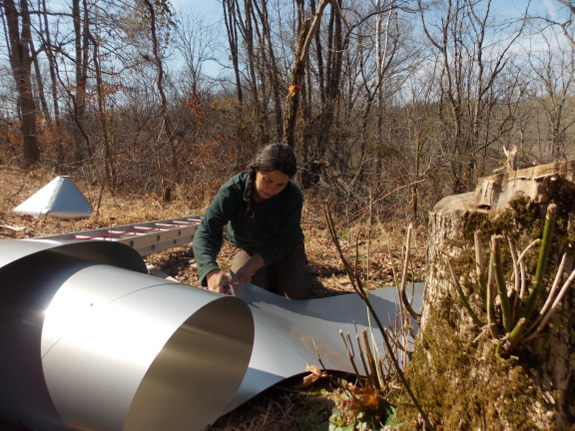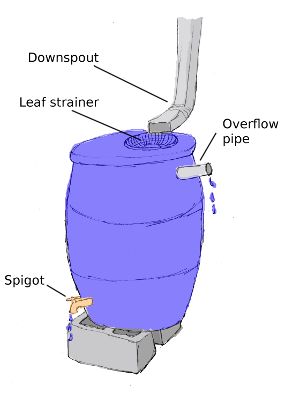
Best roofing material for rainwater collection

Long-time readers will notice that we went back and forth several times on selecting the roofing material for our starplate coop.
Part of the issue is that the roof is made up of five triangles, which
means that normal metal roofing panels would be difficult to
install. But we also spend some time considering which roofing
materials would work well with rainwater collection since we plan to
gutter the coop and then use the collected water for chicken drinking
water and a small duck pond (frequently emptied).
 The consensus on the internet about the safest roofing material for rainwater collection is...there is no consensus. The most definitive study, "Effect of Roof Material for Water Quality for Rainwater Harvesting Systems,"
found that the first flush contained the majority of both the microbial
and chemical contaminants, but even after the first flush, water
contained more turbidity, total coliform, fecal coliform, iron, and
aluminum than is recommended by the EPA for drinking water. Water
was tested from metal, tile, asphalt fiberglass shingle, cool roofs, and
green roofs. "None of the roofing materials emerged as clearly
superior to others in terms of the quality of the rainwater harvested
after the first flush," the study's authors wrote, although they felt
that the green roof and shingles produced water that would be
problematic if treated with chlorine.
The consensus on the internet about the safest roofing material for rainwater collection is...there is no consensus. The most definitive study, "Effect of Roof Material for Water Quality for Rainwater Harvesting Systems,"
found that the first flush contained the majority of both the microbial
and chemical contaminants, but even after the first flush, water
contained more turbidity, total coliform, fecal coliform, iron, and
aluminum than is recommended by the EPA for drinking water. Water
was tested from metal, tile, asphalt fiberglass shingle, cool roofs, and
green roofs. "None of the roofing materials emerged as clearly
superior to others in terms of the quality of the rainwater harvested
after the first flush," the study's authors wrote, although they felt
that the green roof and shingles produced water that would be
problematic if treated with chlorine.
On the other hand, other
websites veto shingles for rainwater collection, even if the water is
only being used on your garden. The biggest concerns seem to be
copper, zinc, lead, chromium, arsenic, and polyaromatic hydrocarbons
leaching out of the shingles, although the grit that comes off the
shingles is also an annoyance in ran barrels. Other roofing types
that some websites recommend avoiding include galvanized metal (which
sheds zinc), any kind of roofing treated to prevent moss growth (which
sheds copper), and flashing made of copper or lead.
In the end, we settled on
aluminum flashing because it's relatively cheap, is easy to work with
on oddly-shaped surfaces, and probably won't hurt our chickens. If
they all come down with Alzheimer's, though, feel free to say: "I told
you so."
Want more in-depth information? Browse through our books.
Or explore more posts by date or by subject.
About us: Anna Hess and Mark Hamilton spent over a decade living self-sufficiently in the mountains of Virginia before moving north to start over from scratch in the foothills of Ohio. They've experimented with permaculture, no-till gardening, trailersteading, home-based microbusinesses and much more, writing about their adventures in both blogs and books.
Want to be notified when new comments are posted on this page? Click on the RSS button after you add a comment to subscribe to the comment feed, or simply check the box beside "email replies to me" while writing your comment.

I drink from aluminum cans and eat foods cooked in aluminum pots occasionally. I don't think that there is much harm in it. And it is such a forgiving metal to work with. Almost as easy as corrugated steel- but that would be a beast on a roof made of five triangles.
I didn't see cedar shingles in your list. Is that because of cost? Complexity? Some reason I haven't thought of?
I've also been playing with the idea of a reclaimed slate roof on a small shed. I'm hopeful that by keeping it small, I can keep the cost and weight down (and be able to do the installation myself)
In any case, thanks for the great progress shots as this came together
@Eric: aluminium (and steel) cans are usually coated with epoxy on the inside to prevent corrosion.
@c.: "baked enamel" might not be what you think it is. Enamel used to be the name for a glass coating on ceramics and metals. But in modern roofing metal it usually means a PVDF coating (kynar 500 / hylar 5000). PVDF is a plastic that has been made corrosion-resistant by replacing half of the hydrogen atoms with fluor. It is a "relative" of the PTFE coating on non-stick pans.
Dominic --- The article I read was very down on wood because it often comes impregnated with copper to prevent the growth of moss. However, if you could find shingles without the copper, I'm assuming it would be similar to other roofing materials. Slate, on the other hand, is usually considered one of the very best for rainwater collection.
Roland --- Thanks for chiming in! That makes enameled metal look much less enticing for rainwater collection.
You said that the runoff from green roofs and shingled roofs would be a problem if you sanitized with chlorine... is that a typo or would adding chlorine really mess that water up? Thanks for the clarification.
@Anna: An admittedly cursory reading of the report you linked to indicates to me that PVDF coated steel roof seemed to perform better on most tests than other roofs, compared to the ambient rain values.
The most general conclusion that I would draw from the report is that rainwater needs treatment before it is good drinking water.
Did you research clay tile or bamboo roofs? Since there are pots made of clay I would think that it is a save material to use. What do you think?
Laura B